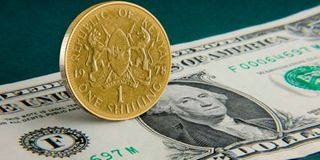Sh1bn daily exchange rate loss on debt as shilling depreciates

Kenyan taxpayers are incurring an extra cost of nearly Sh1 billion every day on US dollar-denominated loans
Kenyan taxpayers are incurring an extra cost of nearly Sh1 billion every day on US dollar-denominated loans following the rapid depreciation of the shilling against the greenback in recent months.
The shilling has sharply declined against the dollar, losing nearly five per cent of its value this year alone. The currency exchanged at an average of 118.1324 units to the dollar on Thursday, from an average of about 103.62 in June 2017, marking a 14 per cent decline. The Treasury indicated in its latest report in April that foreign debts denominated in the dollar were valued at Sh2.885 trillion, or 68 per cent of the Sh4.243 trillion total external debts.
Calculations by Saturday Nation indicate that taxpayers incurred an extra Sh58.5 billion on external debts denominated in the dollar from the end of April to July 7, owing to the shilling’s continued loss of value. By the end of April when the dollar-denominated debt was Sh2.885 trillion, the exchange rate was Sh115.7852.
Depreciation of the Kenyan currency saw the dollar sell at Sh118.1324 by July 7, according to CBK’s official data. This meant that the Sh2.885 trillion external USD debt by the end of April, when the dollar exchanged for Sh115.7852, had risen to Sh2.944 trillion—an increase of Sh58.49 billion in slightly over two months. Between July 6 and July 7, depreciation of the shilling against the US currency saw the exchange rate drop from Sh118.0941 to Sh118.1324 respectively.
This slight change had a huge implication for Kenya’s dollar-denominated debt, as it rose by Sh954.5 million in a single day. In April, the Treasury observed that while the shilling held its own against other currencies, its performance against the US dollar was worrying.
“During the month, the Kenya shilling depreciated marginally against the US dollar by 0.7 per cent. However, against the Yen, Euro, Yuan, and Sterling Pound, the shilling appreciated marginally by 5.5 per cent, 3.9 per cent, 3.2 per cent and 3.3 per cent respectively. The base exchange rate for the afore-mentioned currencies notably the USD, Euro, Yen, Yuan and Sterling Pound was Sh114.95, Sh127.80, Sh94.33, Sh18.10 and Sh151.13 respectively,” the National Treasury stated in its April debt bulletin.
A review of the depreciation trend shows that in the first week of July when the shilling devalued from Sh117.9735 on July 1 to Sh118.1324 on July 7, the burden on USD-denominated debt increased by Sh3.96 billion.
Mr John Gachora, the Kenya Bankers Association chairman, says the depreciation is partly due to the shilling’s high demand locally as traders face high global prices of goods. “The demand for dollars has risen primarily because of the cost of items that we are buying as a country. That means if you are buying a bag of cement today, while it may have cost $10 previously, you need $20 today,” he said.
A look at how the debt has increased as the currency devalued shows that it rose from Sh2.885 trillion as of April 30 to Sh2.9401 trillion by July 1; Sh2.9407 trillion by July 4; Sh2.943 trillion by July 6 and Sh2.944 trillion by July 7.
A further analysis shows that the debt, by April (Sh2.885 trillion), when the exchange rate was Sh115.7852, would have been lower by Sh300.9 billion to Sh2.58 trillion, if the shilling was as strong as it was in June 2017, when it exchanged at Sh103.711.





